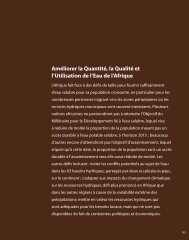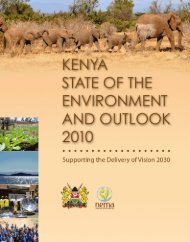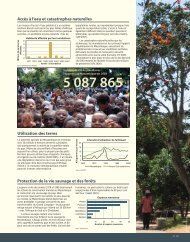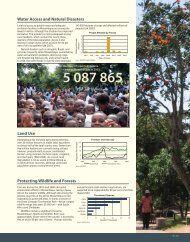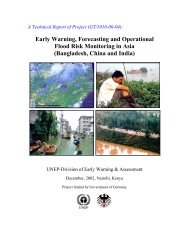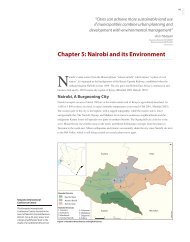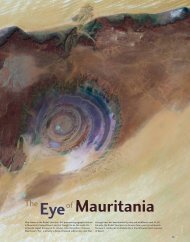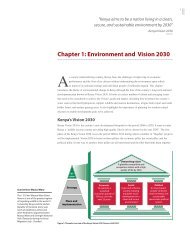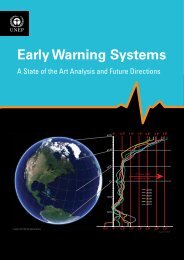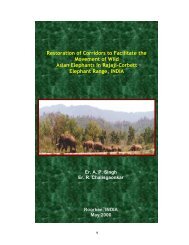Uganda Atlas of Our Changing Environment - GRID-Arendal
Uganda Atlas of Our Changing Environment - GRID-Arendal
Uganda Atlas of Our Changing Environment - GRID-Arendal
Create successful ePaper yourself
Turn your PDF publications into a flip-book with our unique Google optimized e-Paper software.
Kooki hills in Kacheera sub county, Rakai District<br />
<strong>of</strong> deeply weathered regolith, on mudstones and shale<br />
rocks. Ferralic Acrisols (well drained) occur on the upland<br />
pediment slopes and support moderate crop production,<br />
while at the footslopes and valley bottoms, halpic luvisols<br />
are a common feature. In the valley bottoms and river<br />
valleys, a variation <strong>of</strong> deposition related soils occur, both<br />
arenosols and luvisols (for example, Ferralic arenosols,<br />
Halpic arenosols, Halpic gleysols and Arenic gleysols).<br />
Most <strong>of</strong> these soils are <strong>of</strong> medium productivity and tend<br />
to be <strong>of</strong> higher moisture content during the dry season.<br />
Kooki hills are located in the relatively dry zone <strong>of</strong><br />
<strong>Uganda</strong> (the cattle corridor) with climatic conditions<br />
classified as dry sub-humid to semi-arid. Rainfall<br />
records at Kibanda indicate that the area receives about<br />
880 mm annually (Climatology Statistics for East Africa<br />
Part II - <strong>Uganda</strong>; East Africa Meteorological Department,<br />
Nairobi 1975). Occasionally, the area experiences periods<br />
<strong>of</strong> prolonged droughts which sometimes lead to severe<br />
moisture deficit. During this dry season, extensive and<br />
uncontrolled bush burning, a traditional practice mainly<br />
used as a means <strong>of</strong> land clearing for agriculture and for<br />
rejuvenation <strong>of</strong> young and tender grasses for livestock<br />
grazing.<br />
Rakai has over 20,000 head <strong>of</strong> cattle. During the periods<br />
<strong>of</strong> drought and pasture and water deficits, about 70,000<br />
more heads <strong>of</strong> cattle come from other areas in search <strong>of</strong><br />
pasture and water leading to a swelling cattle population<br />
<strong>of</strong> over 90,000 which, in turn, put tremendous pressure on<br />
land, exacerbating the problem <strong>of</strong> overgrazing.<br />
A combination <strong>of</strong> low soil fertility and poor structure,<br />
steep slopes, low available plant moisture, as well as<br />
poor grazing and crop growing practices, is thought to<br />
be the main cause <strong>of</strong> extensive occurrence <strong>of</strong> patches <strong>of</strong><br />
bare ground on the Kooki hills. The rate <strong>of</strong> expansion <strong>of</strong><br />
these bare patches is reported to have recently increased<br />
dramatically, which indicates rapid environmental change<br />
in the area. Consequences <strong>of</strong> this process are far reaching,<br />
especially with regard to reduction <strong>of</strong> grazing land,<br />
increased run<strong>of</strong>f and erosion and, increased sedimentation<br />
problems in the valleys below and in water systems.<br />
With increased degradation to bare ground in upland<br />
areas, people are turning to the valley bottoms and dry<br />
plains, wetlands, river banks, and fragile ecosystems for<br />
both crop cultivation and grazing, leading to yet new<br />
threats <strong>of</strong> degradation and environmental change.<br />
83<br />
Rakai District Local Administration (2007)



